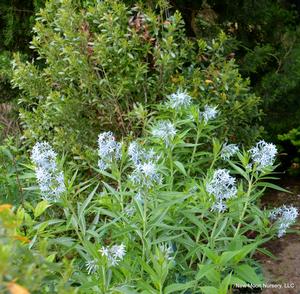Printed at http://www.newmoonnursery.com/index.cfm/
Amsonia illustris
Shining bluestar
Native to North America
FIRST IMPRESSIONS: Like Eastern Bluestar, Shining Bluestar boasts a striking growth habit and pale blue starry flowers. Attractive leaves are thick and glossy. Plants develop a handsome shrub-like form with dense growth and yellow fall color. This resilient native is adaptable to most garden situations and is tough enough to require almost no maintenance.
HABITAT & HARDINESS: This species is sometimes known as Ozark Bluestar. It is indigenous to Kansas, Missouri, Oklahoma, Arkansas and Texas. It occurs most often in sandy or rocky soils, on gravel bars or along streams.
Plants are adaptable to sites outside the natural range from USDA Zones 5-9.
PLANT DESCRIPTION: Shining Bluestar is a sturdy warm season perennial. Plants form an erect dense clump that becomes more striking with age. Mature plants average 3’ tall and 3’ wide.
Foliage is leathery and shiny with a narrow willow-like shape. Autumn foliage is tinted in a lovely clear yellow shade.
Blooms are pale periwinkle blue and star shaped in late spring and early summer. This is reported to be a very floriferous Amsonia producing large dense flower clusters.
CULTURAL & MAINTENANCE NEEDS: Shining Bluestar is easy to grow in average, medium, well-drained soils in full sun to part shade. Established plants will tolerate some drought.
When grown in too much shade or in very fertile soils, plants may flop and require staking or pruning. Cutting stems back by half or a third after flowering will promote denser growth and stronger stems.
The slightly toxic latex sap cause this plant to be unpalatable to insect pests and foraging herbivores like deer and rabbits. Flowers attract swallowtail butterflies and other pollinators.
LANDSCAPE USES: The clean shiny foliage and heavy flower production make this Bluestar an excellent candidate for use as an Accent. It can also be used as a Butterfly Nectar Plant, Group or Mass. It injects Fall Color and Showy Blooms into the landscape. Plants are valuable components of Cottage Gardens, Deer Resistant Plantings, Water-wise Landscapes, Low Maintenance Plantings, Meadow or Prairie Gardens, Perennial Borders, Shade Gardens and Wildlife Gardens.
COMPANION & UNDERSTUDY PLANTS: Shining Bluestar blooms coincide with those of meadow phlox, false indigo and beard tongue. The golden fall foliage is attractive with fall asters like ‘Raydon’s Favorite’.
Other Amsonias like the closely related Amsonia tabernaemontana v. salicifolia or Amsonia tabernaemontana can be substituted if this one is not available.
TRIVIA: Richard T. Hawke of the Chicago Botanic Garden conducted a comparative study of 11 taxa of hardy amsonias. Amsonia illustris was one of the two with the highest rankings. According to the study, this species “…received excellent ratings because of high flower production, superior habit, good health and winter hardiness.”
Amsonia is a member of the Dogbane Family (Apocynaceae). Family members like the infamous oleander typically have milky or viscous sap that can be loaded with highly toxic alkaloids. The Bluestars’ latex sap is mildly irritating and not considered to be harmful to humans. It does make the plant unappealing to foraging rabbits, deer, insects and slugs and other garden pests.
Very similar in appearance to Amsonia tabernaemontana, except the leaves of this species are shinier, thicker and more leathery and the seed pods are dangling rather than upright.
Height:
3-4 ftSpread:
3 ftSpacing:
3-4 ftUSDA Hardiness Zone:
5-9Bloom Color:
BlueAmsonia illustris Characteristics
Attributes
- Interesting Foliage
- Rain Garden
- East-Coast Native
- Drought Tolerant
- Dried Flower
- Cut Flower
- Bog
- Naturalizing
Exposure
- Full Sun to Partial Shade
Deer Resistant
- Deer Resistant
Flowering Months
- July
- June
- May
Foliage Color
- Green
- Gold
Growth Rate
- Medium
Season of Interest (Foliage)
- Fall
- Spring
Soil Moisture Preference
- Moist

